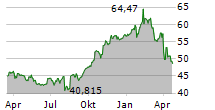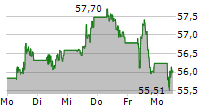
NORTHAMPTON, MA / ACCESSWIRE / December 4, 2024 / Cisco Systems Inc.
By Fausto Vaninetti
In today's increasingly interconnected world, networking equipment and secure operations have become essential to nearly every aspect of business and daily life. This is even truer for storage networking since data access is vital to applications, including the Artificial Intelligence (AI) realm. As reliance on networking infrastructure grows, so does the need to advance sustainability in business practices and technologies. With the intent of progressing toward a more sustainable future, organizations can benefit from designing storage area networks (SANs) that are not only secure, high performance and reliable, but also with less impact on the planet. At Cisco, we have a goal for 100% of new Cisco products and packaging to incorporate Circular Design Principles by Cisco's fiscal year 2025. Circular design means designing products and systems that enable reuse, minimize environmental impacts, drive innovation, and realize value for our stakeholders.
This blog post addresses the following topics relating to sustainability in SANs:
Combining energy consumption reduction and circularity
Sustainability in hardware and software design with monitoring included
Striving to evolve to a regenerative, circular model for products and packaging
Design best practices
Combining energy consumption reduction and circularity
Both energy consumption and power efficiency are critical factors when architecting sustainability in SANs. Energy consumption not only has an environmental impact but also contributes to operating costs. As such, choosing power-efficient switches is crucial. The Cisco MDS 9000 series switches are an excellent example of networking equipment optimized for the SAN designed to reduce energy consumption and operating costs while maintaining high performance and resiliency. This value proposition can get even stronger when paired with engineering efforts to align with the principles of a circular economy. Consider the ability to upgrade-in-place to a new generation of linecards and minimize replacement of parts. Consider the extended lifetime derived from a modular and highly reliable design. Consider the ability of extended use by loading the latest firmware release on the portfolio on sale, enabling an updated feature set and a solid security posture. This can help reduce the contribution of embodied carbon to overall greenhouse gas (GHG) emissions.
Sustainability in hardware and software design with monitoring included
The Cisco MDS 9000 series switches follow hardware design guidelines that support activation of several software features to facilitate a reduced power footprint. The switching application-specific integrated circuits (ASICs) keep evolving along a trajectory of doubling power efficiency (Gbps/Watt) at new generations. Moreover, current 64G chipsets incorporate the ability to reduce energy consumption while reducing port speed, further contributing to power efficiency in SANs. Power supplies hold third party Titanium certification for up to 96% efficiency.
Smart software capabilities keep gaining in importance. They allow for remote powering off of individual components such as switching modules and power supply units when they are not needed. This way SAN administrators can benefit from ready-to-activate spare components, minimize energy consumption and increase power efficiency. In addition, the recent transceiver power control feature introduces industry-unique power reduction innovation at the port level. The combination of these advanced power management features helps optimize energy consumption of SANs, which can minimize energy waste and reduce operating costs.
Improvements in the energy posture can be automatically captured and tracked. For example, the Nexus Dashboard management tool can monitor and display real-time and historical trends of consumed electrical power for Cisco MDS 9000 series switches. In conjunction with the Panduit Intelligent Power Distribution Units (iPDUs), it becomes possible to collect and unify IT and facility data points, gaining visibility of sustainability metrics at the site, equipment, or PDU outlet level.
Striving to evolve to a regenerative, circular model for products and packaging
Cisco's focus on sustainability goes beyond energy efficiency in products, as we also have initiatives in place to help reduce waste. Cisco is a member in the World Business Council for Sustainable Development (WBCSD), Circular Products and Materials pathway. This pathway focuses on promoting and implementing circular economy principles in the production and use of materials and products. With our Product Takeback and Reuse Program, customers can responsibly return their used networking equipment at no cost. Cisco strives to process returned products to their next best use, whether it is refurbishing, reusing, reselling or harvesting their components and responsibly recycling them. Cisco reuses or recycles nearly 100 percent of products that are returned to us. Where applicable, customers can even opt-in to receive a Certificate of Recycling (COR), further promoting a circular economy approach.
Additionally, our focus on improving packaging and reducing plastic enables Cisco MDS 9000 series switches to stand out in the overall networking landscape. Reduction of plastic bags for transceivers and accessories, reduction of virgin raw materials in favor of recycled materials, improvements in product packaging cube efficiency: this pinpoints the current ambitious direction for product development and packaging.
Design best practices
When architecting sustainability in SANs, there are several best practices to consider. Virtualization and consolidation in the compute farm can reduce the number of physical switches and ports needed, which can help lower energy consumption and operating costs. Enabling advanced power management features on devices, such as those offered by the Cisco MDS 9000 series switches, can help further reduce energy usage. Topology considerations and product selection can also make a difference. The adoption of port-optimized low-power fabric switches for small SANs or top-of-rack deployments can help minimize energy consumption and cabling. When appropriate, the move to a multi-fabric collapsed core design with the Cisco MDS 9718 can help reduce the number of chassis and inter-switch links (ISLs), supporting tangible power and cost savings. The MDS 9718 can have up to 768 ports, allowing a moderately sized SAN to exist on a single switch. This means that ports can be connected to end devices instead of "wasted" on ISLs. A larger SAN can be designed with multiple MDS 9718 directors, each operating as an individual fabric. Finally, monitoring energy consumption and utilization can help identify areas for improvement, and choosing energy-efficient equipment and components can help maximize energy savings.
Cisco MDS 9000 series can help advance sustainability in your SAN
Architecting sustainability in SANs is essential for organizations moving toward more sustainable practices and looking to reduce their carbon footprint and operating costs. Power-efficient switches, such as the Cisco MDS 9000 series, can offer advantages in terms of energy consumption and cost savings. Organizations can also benefit from Cisco's sustainability initiatives, such as Cisco's Takeback and Reuse Program and our plastic reduction efforts. By following these practices, organizations can design SANs in a more sustainable way, which can benefit the environment and their bottom line. Modernizing SANs with sustainability in mind can help yield a high Return on Investment. We estimate that, over five years, the energy and footprint savings from the old systems can sometimes cover the cost of the new SAN, effectively allowing organizations to "pay for" the upgrade through operational efficiencies.
References
Cisco's environmental, social, and governance (ESG) Reporting Hub
Cisco evolving the business to circular economy
Cisco's Product Takeback and Reuse program
View original content here.
View additional multimedia and more ESG storytelling from Cisco Systems Inc. on 3blmedia.com.
Contact Info:
Spokesperson: Cisco Systems Inc.
Website: https://www.3blmedia.com/profiles/cisco-systems-inc
Email: info@3blmedia.com
SOURCE: Cisco Systems Inc.
View the original press release on accesswire.com



